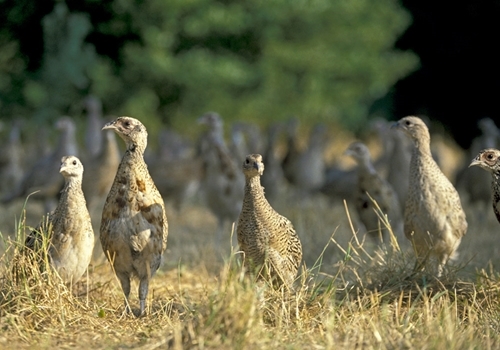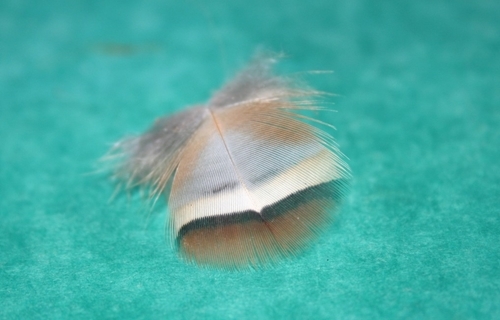4 Minute Read
Written by Mike Swan, GWCT Senior Advisor

For most lowland shoots, the cost of pheasant and partridge poults is probably the biggest single outlay in the annual budget, so you want to spend your money wisely. Shopping around is clearly sensible but beware of going on price alone. All poults are not equal, and it is an ancient axiom that the cheapest price is rarely the best value for money.
Pheasant strains and subspecies
I am often asked about strains of pheasants, and what sort has those magic qualities that we all want. For the gourmet they need to eat well, but I think they all taste much the same, so what we are interested in is that they fly like dingbats. We also want them to hold to the shoot like glue, and that those left after the season produce big broods in the wild.
It is important to understand that many of the so-called strains are really brand names, rather than descriptions of a particular breed. A couple of decades ago people talked of Scandinavians, Michigan Blue Backs, and Kansas for example. Nowadays we have Bazanty, supposedly from Poland, and French Common. Since all pheasants originate in Asia, we can safely say that none of these terms describes a properly recognisable race; even the name Old English Blackneck is spurious.
Against this background comes a very complex taxonomy with up to thirty described subspecies of the common pheasant, plus two of the Japanese Green, which is usually considered to be a separate species. All sorts of different subspecies have been imported into the UK, and while specialist keepers of ornamental pheasants may well have kept some of these properly distinct, most of the pheasants in both game farms and our countryside could reasonably be described as mongrels.
It is fair to say that blacknecks, the ones with no white neck ring, were the first to come here. Whether they really came with the Romans, or later, is lost in the mists of time, but they were surely the first pheasants to make it into Europe, simply because they are the most western race. After that, in Victorian times when pheasant releasing for shooting kicked off, all sorts made it here, including what in its day was called the Prince of Wales’s Pheasant, plus lots of paler Chinese ring-necked types.
So, lets talk quality...
I long ago came to fundamental conclusion; strain alone brings no guarantee of performance, and I don’t think there is much to choose between them, although I have a hunch that the palest of pheasants, with their origin in continental China may be a bit more prone to wandering. They clearly do not migrate, but having bred in the hills of their homeland, they may just be programmed to walk downhill to more sheltered winter homes. Perhaps that instinct results in a stronger tendency to autumn dispersal.
What I am also convinced of is that domestication is not good if we want our birds to perform like real wild ones. Aside from racehorses and working dogs, pretty much everything that we have domesticated is fatter and slower than the wild originals. In the breeding of pheasants and partridges we ignore this trend at our peril. The simple business of keeping birds in captivity adds an evolutionary selection pressure which works against the most difficult or flighty, but on top of this comes the issue of catching up.
From the start of pheasant rearing, keepers have caught birds from the wild to place in laying pens for egg production. Way back, when most of the pheasants out there were wild bred, that probably did no harm to stock quality, but now that the majority are released birds that have survived the season, a different perspective arrives. What we are now catching up from is mostly the ones that would not or could not fly high enough to tempt the Guns. In other words, we are catching up from the fat and lazy left-overs.
A closed flock
One or two of the oldest established game farms have always maintained a closed flock, keeping back their breeding stock from year to year, and not importing any extra birds. This means that compared to caught up hens, they are not importing the fat and lazy, as well as avoiding any parasites and diseases that might come with them.
So, my first question in finding good birds is not what strain, but to ascertain that I am buying from a closed flock. Having had an assurance that this is so, you could be cheeky and ask if they are in the market for some caught up hens, or whether they would custom hatch some of your own eggs. If the answer to either question is yes, they are fibbing about the closed flock. My next question is to check whether they are a Game Farmers Association member, because this gives a good indication that they follow the GFA code, rearing their birds to a high standard.
The attention to detail involved is likely to add to the cost, but a good quality bird competitively priced is far better that cheap rubbish. Prices for pheasant poults have gone up significantly this year, and the combined impact of hikes in the cost of feed and fuel will probably add a bit more yet, even if the current supply crisis due to bird flu restrictions in France resolves itself. Published prices for 2022 at around £4.50 may well no longer apply if you are still shopping.
Shop local
Being caught, bundled into a crate and transported to a very different environment from the rearing field is stressful, and adding any other pressures is not helpful. Same food, same feeders, same drinkers are well known mantras, but keeping travel distance short should be another. The longer birds are in transit, the more tired they will be on arrival, and if it turns out warm, heat stress is another risk that you would rather avoid.
Go and visit
A visit to the game farm becomes much easier if you shop local too, and a proper professional game farmer should welcome you, but do expect to play by the rules. Every visitor to the premises is a potential source of infection, so make sure your vehicle is properly clean and that you wear clean clothes and boots. Expect to be asked to dip in disinfectant foot baths, and perhaps even to don a set of clean overalls supplied by the farm. All this is good hygiene, and an indication of a well-run operation that you can have confidence in.
I would also ask about any medication that may have been used during rearing; hopefully none has been needed, but a proper treatment history for your birds is important. Another value in going local is that you can use the same vet if the need arises, confident that they know the history.
Are they a good sample?
When your poults arrive, take the time to sit back and watch them for a while after they have been liberated from their crates. Do they look like a good sample? Are they sleek and well feathered? Are they all much the same size, with no obvious tiddlers or much bigger ones. Size disparity can indicate variable growth due to an earlier disease outbreak. It can also mean that there has been some mixing of batches, which brings extra disease risk through cross infection. Also, are they lively and up on their toes? Taking time to watch soon reveals if there are odd ‘slouchers’ that are feeling poorly; the first indication of a possible health issue for the rest.
Keeping up the good husbandry and hygiene is important. If you have shopped well, and you then put in the effort, and look after them, the birds will be a tribute to you when the shooting season comes around.

A flank feather with hint of second dark bar, indicative of chukar in the ancestry of the bird
Redleg strains
Compared to pheasants, there are no ‘strains’ of redlegs, but do be aware of hybrid blood. An experiment in the 1970s and 80s using the Chukar partridge, because it is cheaper and more productive, has left a legacy of genetic contamination. It is now illegal to release Chukars and their hybrids, but you would not want to anyway, because they just do not fly like pure redlegs. Hybrids usually have at least the shadow of a second black bar on their flank feathers, and any decent game farmer will be on the lookout for this, culling any suspicious birds from their stock.
This article first appeared in Shooting Times